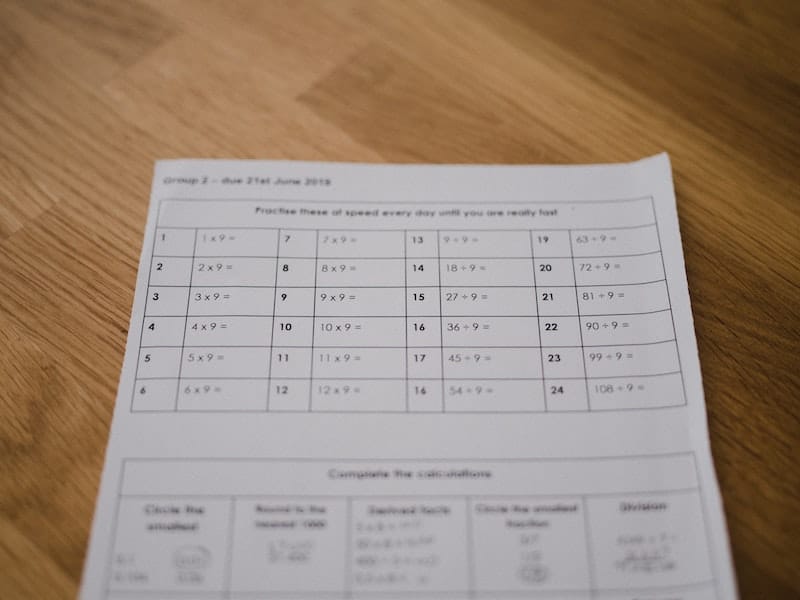
Kids won't understand times tables until they've mastered addition
In order to be successful with maths, kids must understand that maths is sequential. It's like a basic law of the universe, the same laws that govern gravity and Einstein's theory of relativity.
If your child knows how to add numbers together one by one, then adding them quickly in groups (such as times tables) will be easy for them. When kids can successfully multiply, they understand that instead of counting each number by itself (1 + 2 + 3 + 4) they can simply multiply, or "fast add."
However, when a solid understanding of addition is not there, kids struggle with times tables, multiplication and "fast adding". This gap in their knowledge then spirals to affect all other maths concepts they are being taught, until kids get to high school and still don't understand Place Value. They still count with their fingers and can't conceptualise numbers to get the correct answer because they don't have a tactile, numerical foundation to build from.
It's a common and increasingly frustrating problem for parents, teachers and schools alike, but thankfully, it's an issue that has a very simple solution.
What are times tables?
Times tables is another word for multiplication tables.
Multiplication is the process or skill of multiplying. It is also referred to as "fast adding" or "skip counting". However, as simple as the definition may be, teaching multiplication is usually not as easy as it seems.
The following is an example of multiplication:
3 × 7 is the same as 7 + 7 + 7 = 21
5 × 6 is the same as 6 + 6 + 6 + 6 + 6 = 30
As you can see, by "fast adding" and skipping the middle numbers, you can add up the total value of the numbers and find the answer much quicker. However, most students struggle with this concept. Why are there so many numbers? Where did they come from? And how do I know that I've gotten the correct answer?
By teaching addition first and laying a proper foundational understanding of numbers, your child will be able to progress effectively through multiplication and even on to algebra. By using these simple methods, you will be able to confidently teach your child maths skill they can use in everyday life situations, further study, employment opportunities and their ongoing careers. It's definitely worth getting right!

Why do kids struggle with times tables?
If you are a parent who is feeling frustrated by watching your child struggle with maths, you're not alone. Many parents, especially when they don't feel confident to teach maths, often feel frustrated and overwhelmed when nothing seems to work.
For a short time, flash cards, drill sheets, rewards and incentives might make some headway with maths lessons. The results reveal, however, that many of those "learned" math facts slip away from short-term memory after a break from lessons. For most students, sheer willpower and complete dedication is needed to get those facts into rote memory and unfortunately, it doesn't make the knowledge stick.
If your child doesn't understand what they are doing and the foundational aspects of numbers behind times tables, using drill sheets and memorising facts won't work. Sometimes, it actually makes it worse! Think about it. What if you as an adult wanted to learn something and your instructor said, “Just do it faster, and I will time you”? No wonder some children experience anxiety attacks with maths.
Here's a few simple strategies to learn times tables
When your kids are struggling with times tables and multiplication, it's important to have some key strategies to start filling in those gaps of mathematical understanding. To achieve the best results, it's important to firstly understand the key components of maths. Once you understand these components, you'll have the knowledge you need to tackle maths confidently.
Here's a few important strategies you can start using straight away:
It takes courage and the right kind of knowledge to know what your child needs to successfully learn maths. By using specific methods, tactile tools and a thorough program to teach maths throughout your child's education is the simplest and easiest way to go. The Math-U-See program is the best example of combining all the right tools for maths and achieving excellent results! I used this program for my five daughters from preschool to high school maths, and they all understand and can use maths very effectively!
The Math-U-See program has also been an effective maths solutions for thousands of kids worldwide. By teaching in a way they understand, kids will be able to confidently use maths not only in tests and exams, but also in everyday life. It's not fair for kids to consider themselves a failure in maths simply because they aren't taught using the right tools and a proper methodology!
Want to check your student's maths understanding?
Before going any further with maths, it's a good idea to check what your child knows and what they don't know. By taking a clear snapshot of their current understanding, you'll know where to start to fill in those gaps of knowledge, and how to support your child as they continue their learning.
Here's a simple diagnostic test to check your child's maths knowledge:
Hope that helps with teaching your kids maths in a way they can understand and use. Being able to fully understand and successfully use maths in day to day life affects your child's entire education, so it's important to get it right while you can.
If you want some more support teaching maths, we've got specific Parent Training that walks through foundational maths concepts in a step-by-step way. You'll have everything you need to confidently teach your child maths, even if you haven't had any prior experience.
Wishing you the best maths journey,
Warmly,
Esther White

